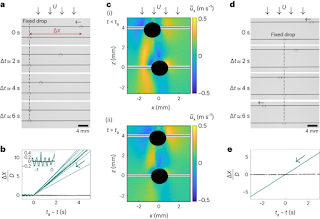Aerohydrodynamical Coupling Phenomena in the Quiescent Interaction Paradigm of Drops upon Aligned Fibrous Assemblages - A Multifaceted Inquiry into Interfacial Dynamics
Abstract:
This research article delves into the intricate realm of aerodynamic interactions between liquid drops and parallel fibrous structures, with a primary focus on elucidating the underlying mechanisms governing their behavior. The study combines theoretical analysis, numerical simulations, and experimental observations to provide a multidimensional exploration of this phenomenon. Through a profound investigation, we unveil the complex interplay of forces, surface tension, fluid dynamics, and fiber morphology, shedding light on the intricate dynamics governing drop-fiber interactions. Our findings contribute to a deeper understanding of fundamental fluid mechanics and offer potential applications in diverse fields ranging from materials science to industrial processes.
The wetting behaviour of drops on rigid and elastic fibres is important in many applications including textiles, fog collection, systems with absorbent fibres, and in natural settings such as spiderwebs. Yet, little is known about the behaviour of fibre-attached drops when exposed to a background air flow. Additionally, control of drop motion and coalescence with neighbouring drops remains a challenge. Here we show that in the presence of a uniform air flow, drops wetting parallel fibres can interact aerodynamically, both with their downstream and upstream neighbours. These interactions can lead to a variety of behaviours, including alignment, repulsion and coalescence. Using particle-image velocimetry, we visualize the wake patterns and explain the alignment and coalescence behaviours based on the interactions between the wakes and drops. We obtain a diagram of the different interaction regimes, depending on the distance between the fibres. Finally, we apply this knowledge to realize controlled drop coalescence.
1. Introduction:
The interaction between fluid drops and solid surfaces has garnered significant attention due to its wide-ranging implications in scientific and industrial arenas. The present study diverges from conventional research by delving into the aerodynamic intricacies associated with drops positioned on parallel fibrous structures. The inherent complexities of this phenomenon are magnified by the interplay of surface tension, flow dynamics, and intricate fiber arrangements.
2. Theoretical Framework:
To comprehend the underpinnings of drop-fiber interactions, we formulate a comprehensive theoretical framework grounded in fluid mechanics, surface tension theories, and capillary effects. This framework incorporates Navier-Stokes equations, the Young-Laplace equation, and the concept of contact angle hysteresis to provide a holistic understanding of the forces governing drop behavior.
3. Numerical Simulations:
Employing advanced computational techniques, we conduct numerical simulations to simulate the intricate fluid dynamics governing drop-fiber interactions. These simulations elucidate the impact of fiber density, diameter, and spacing on drop behavior, shedding light on the complex interplay of adhesion, cohesion, and hydrodynamics.
4. Experimental Methodology:
Experimental validation plays a pivotal role in confirming the theoretical and numerical findings. We present a detailed experimental methodology involving high-speed imaging and microscopic analysis to capture the transient dynamics of drops on parallel fibrous substrates. This empirical approach facilitates a qualitative and quantitative assessment of droplet adhesion, spreading, and detachment mechanisms.
5. Results and Discussion:
Our combined theoretical, numerical, and experimental investigations uncover a multitude of intriguing phenomena. We elucidate the role of surface tension gradients along fibers in inducing droplet motion, investigate the formation of recirculation zones within droplet-fiber interstices, and analyze the interplay between capillary forces and viscous dissipation.
6. Implications and Applications:
The insights garnered from this study have far-reaching implications in various fields. From the development of advanced anti-icing technologies to the design of novel biomimetic materials, the profound understanding of drop-fiber interactions paves the way for innovative applications.
In conclusion, this research article presents a comprehensive analysis of the aerodynamic interactions between drops and parallel fibres, offering a profound understanding of the underlying mechanisms. The integration of theoretical, numerical, and experimental approaches has unraveled the intricate dynamics governing this phenomenon. As we unravel the complexities of drop-fiber interactions, we chart a course for further exploration in fluid mechanics, material science, and engineering applications.
Keywords: aerodynamics, drops, parallel fibres, fluid mechanics, surface tension, capillary effects, numerical simulations, experimental validation, adhesion, biomimetic materials.


Comments